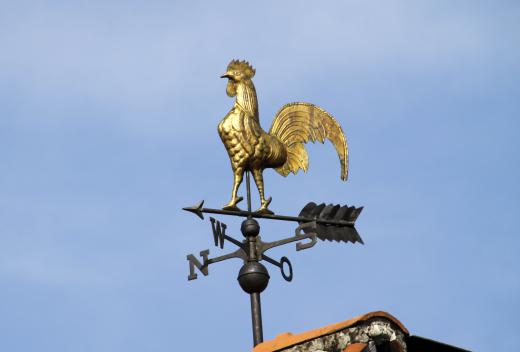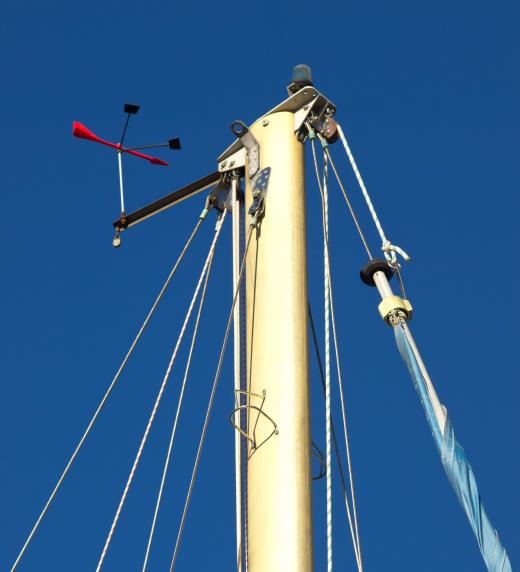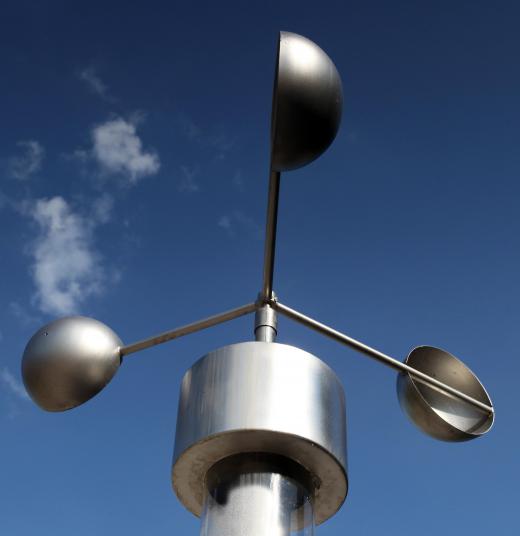What is a Wind Vane?
A wind vane, also known as a weather vane, is a tool used to determine the direction the wind is blowing from. These instruments have been in use for centuries, dating from around 50 BCE. They come in many designs, from sleek and professional to ornamentally fun, but they usually follow similar aerodynamic design rules. A number of giant wind vanes exist, and there is a dispute about the largest one in the world.
Uses

The current wind direction, combined with knowledge of the geography of a region, can often provide a good indication of how the weather may change over the next day or two. For this reason, a wind vane is often used in weather forecasting. If the wind is blowing from a warm ocean, for example, mild, cloudy, and wet conditions can be expected. Wind vanes at weather stations record wind direction electronically, to provide permanent records. They are used in conjunction with anemometers, which measure wind speed.

Weather vanes are also used at airports, as wind direction is an important factor for incoming and outgoing airplanes. Another use is in sailing: a type of automatic steering system employs a sailing wind vane connected to a rudder to keep the boat or yacht on course.
Design and Construction
The modern version is usually constructed of lightweight metals in order to provide responsiveness to light winds, durability in a variety of weather conditions, and also because of metal's ability to be forged precisely. This precision is important to vane developers because the weight of the device needs to be distributed evenly in order for it to function properly. The simplest design involves an arrow on a rotating axis with the points of the compass labeled below. The arrow's design is crucial for the success of the vane, because it has one large end and one smaller, pointed end so that it will point in the direction from which the wind is blowing.

Using this basic setup, many more elaborate forms — shaped like animals, ships, and people, for example — can be constructed. Such designs may not give a very accurate indication of wind direction if there is only a light breeze, however, and they tend to be ornamental rather than functional in purpose. A simple weather vane can easily be constructed from everyday materials, making it a popular school science project.
Positioning

To provide accurate wind directions, weather vanes need to be high above the ground. Near the ground, obstacles such as buildings and trees cause winds be deflected or swirl around, so that it is not possible to determine the correct wind direction. The vanes are usually placed on top of tall buildings or on purpose-built structures, where no nearby taller objects can interfere with the air movement.
History
The earliest recorded wind vane is thought to be a large bronze statue of the god Triton placed on top of the Tower of the Winds in Athens, Greece. It was able to rotate and indicated the wind direction. Below it were representations of the gods associated with the eight wind directions, along with sundials and a water clock. It is thought to date from around 50 BCE.
In Christian countries, there is a long tradition of installing weather vanes on top of church towers. Generally, they incorporated a cock, or rooster, into the design. The practice is thought to date from the 9th century, when the animals seems to have become a Christian symbol, following papal pronouncements. Later, many other, often very elaborate designs began to appear, some of which are much sought after as antiques.
Modern wind vanes are often of much simpler and strictly functional design to maximize their sensitivity and the accuracy of the readings. They also dispense with directional indicators, as the data is recorded automatically by computer. Decorative ones are still available, however, for individuals who simply like their look.
Notable Wind Vanes
The Guinness Book of World Records has recognized a weather vane advertising a brand of sherry in Jerez, Spain, as the world’s largest. This is disputed, however, and there are a number of other candidates for the record. Perhaps the most remarkable is located at a transportation museum next to Whitehorse International Airport in Yukon, Canada. It consists of an actual DC-3 airplane mounted on a rotating column. Despite its bulk and weight, it will respond to a wind of just 5 knots (5.75 mph or 9.26 kph).
AS FEATURED ON:
AS FEATURED ON:














Discussion Comments
I'm in high school doing a project about weather and what instruments you use to tell the weather and this page has really helped.
@ ValleyFiah and Istria- Unbelievably, wind and weather vanes can fetch a lot of money at an antique auction. The use of wind vanes was a very folksy and rural phenomenon that reflected the farm art of the times. Old copper and iron weather vanes can even pull in over a million dollars at auction. The allure to antiques is nostalgia, and the weather vane is very symbolic of America during its most prosperous years. Pieces that had movement, intricately hammered and molded sculptures of horses, birds, and farm animals, are very valuable. The images, detail in the images, oxidation of the metals, and age of the piece are the biggest factors in the price. Essentially, the older, more detailed, more movement of the subject, and more natural oxidation of the metals makes for the most valuable weather vanes.
@ istria- That seems like a crazy price to me. I don't think that any weather vane could fetch that much money. I don't know anything about antiques really, but when I traveled New England I saw duck, horse, boat, and rooster wind vanes all over the place. I agree with you, how can something like that be so valuable.
Wind vanes are big business in the antique world. I remember this from when I lived in Vermont. Someone was going around cutting the 250-year-old wind vanes off the roofs of barns and farmhouses so that they could be sold on the black market. The paper had said that thieves could fetch upwards of $150,000 for these weather vanes, even if the acquisition was questionable. Many of these farmers never even had a clue that the old rooster wind vane sitting on their barn was worth that much. Last I knew, the thieves were never caught. Sometimes I am amazed at the price of antiques, but this definitely takes the cake. What is so special about a wind vane is a mystery to me.
Post your comments